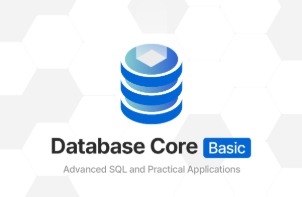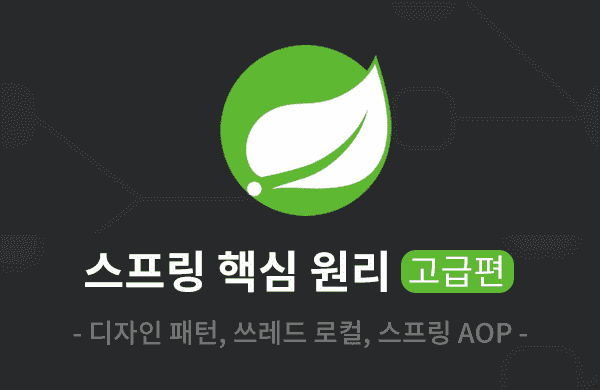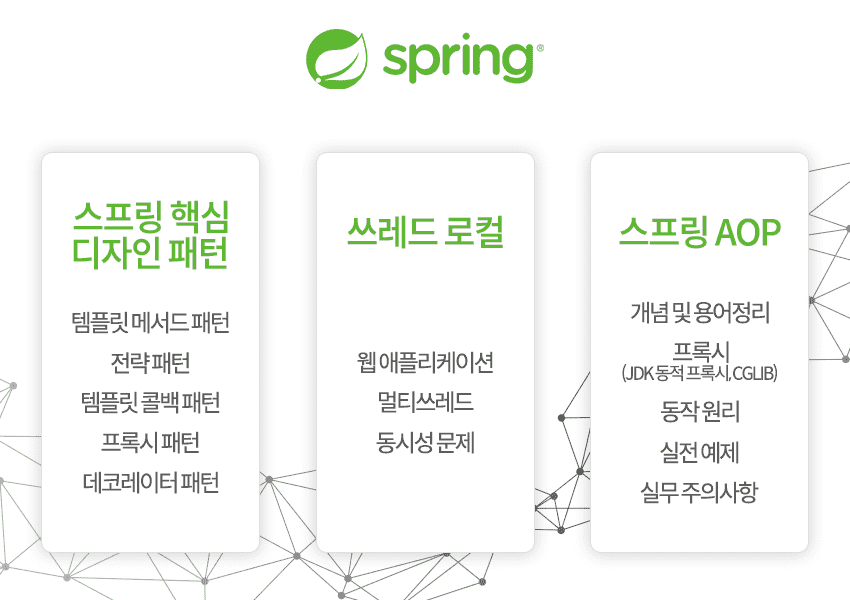
김영한의 실전 데이터베이스 - 기본편
김영한
실무에 꼭 필요한 SQL과 데이터베이스의 기본기를 학습합니다. 개발자뿐만 아니라 기획자나 데이터 분석가분들도 SQL을 깊이있게 학습합니다.
초급
SQL, MySQL, DBMS/RDBMS
핵심 디자인 패턴
스프링 고급 기능
스프링 AOP
핵심 디자인 패턴, 쓰레드 로컬, 스프링 AOP
스프링의 3가지 핵심 고급 개념 이해하기
📢 수강 전 확인해주세요!
스프링 핵심 원리 - 기본편

실력 있는 개발자가 되려면 실무에서 자주 사용하는 도구를 깊이 있게 이해해야 합니다.
스프링은 실무에서 가장 많이 사용하는 백엔드 기술입니다.
따라서 백엔드 개발자라면 스프링을 깊이 있게 이해하는 것이 중요합니다.
우리는 앞서 스프링 핵심 원리 - 기본편에서 스프링과 객체 지향 개발의 기본기를 학습했습니다.
스프링을 깊이 있게 이해하고, 실무에서 실력 있는 개발자가 되려면, 기본편에서 학습한 내용을 기반으로 크게 3가지 핵심 고급 개념을 알아야 합니다. 이번 스프링 핵심 원리 - 고급편에서는 이러한 고급 개념을 학습합니다.
1. 스프링 핵심 디자인 패턴
2. 동시성 문제를 다루기 위한 쓰레드 로컬
3. 스프링 AOP

1. 스프링 핵심 디자인 패턴
스프링의 내부 기술들은 몇 가지 핵심 디자인 패턴으로 만들어져 있습니다. 따라서 스프링을 깊이 있게 이해하기 위해서는 먼저 스프링이 자주 사용하는 핵심 디자인 패턴들을 알아야 합니다.
강의에서 전달하는 핵심 디자인 패턴
강의에서는 이러한 디자인 패턴들을 예제 코드로 하나하나 만들어보면서 아주 쉽게 설명해드립니다. 그리고 이렇게 학습한 디자인 패턴을 애플리케이션에 적용하는 방법도 알아봅니다.
2. 쓰레드 로컬
스프링은 주로 웹 애플리케이션 개발에 사용됩니다. 웹 애플리케이션은 동시에 여러 요청을 처리하기 위해 멀티쓰레드를 사용합니다. 따라서 여러 쓰레드가 경합하는 동시성 문제가 발생할 수 있습니다.
강의에서 전달하는 동시성 문제와 쓰레드 로컬 내용
강의에서는 스프링을 사용할 때 발생하는 동시성 문제를 알아보고, 또 동시성 문제를 편리하게 해결할 수 있는 쓰레드 로컬 개념까지 학습합니다.
쓰레드 로컬은 멀티쓰레드 환경에서 스프링이 어떻게 동시성 문제 없이 잘 작동하는지 이해하기 위한 필수 개념입니다.
3. 스프링 AOP
스프링 AOP는 실무에서 정말 많이 사용되는, 마치 마법처럼 느껴질 정도로 편리한 기술입니다. 많은 개발자가 스프링 AOP를 사용하지만, 스프링 AOP가 어떻게 동작하는지 그 원리를 정확하게 이해하고 사용하는 개발자는 많지 않습니다.
단순히 스프링 AOP의 기능만 알고 사용하는 단계를 넘어서, 스프링 AOP의 동작 원리를 깊이 있게 이해해야 장애가 발생했을 때 근본적인 문제 해결이 가능합니다.
강의에서 전달하는 스프링 AOP 내용
강의에서는 스프링 AOP의 단순한 기능 정리를 넘어서 동작 원리부터 실전 예제, 그리고 실무에서 자주 발생하는 주의 사항까지 스프링 AOP의 모든 것을 정리해드립니다.
기타
추가로 스프링 컨테이너의 고급 기술인 빈 후처리기와 스프링 애플리케이션을 개발하는 다양한 실무 팁도 전해드립니다.
고급편인 만큼 이 강의에서 다루는 내용들은 쉬운 내용들이 아닙니다.
하지만 실력 있는 백엔드 개발자가 되려면 반드시 한번은 공부해야 하는 내용입니다.
포기하지 않고 이 강의를 끝까지 따라오시면 여러분은 개발자로서 엄청난 내공 상승을 경험하고 누구보다 자신있게 스프링을 사용하실 수 있게 됩니다.
어려운 내용이니만큼 저도 철저하게 강의를 준비했습니다. 여러분이 이 내용들을 본인 것으로 완성할 수 있게 도와드리겠습니다.

스프링을 더 깊게
알고 싶은데…
스프링의 고급 개념을
학습함으로써 실력을
더 키우고 싶은 분

스프링 AOP를
사용하기는 하는데…
스프링 AOP의 동작
원리를 정확하게
이해하고 싶은 분

스프링을 코드로
이해하고 싶은데…
디자인 패턴을 통해
스프링의 내부 기술을
이해하고 싶은 분

스프링으로 웹 앱을
만들 생각인데…
쓰레드 로컬을 통해
스프링 동시성 문제를
이해하고 싶은 분
스프링을 완전히 마스터할 수 있는 시리즈를 준비하고 있습니다. 실제 실무에서 사용하는 핵심 스프링 기능을 중심으로, 실무에서 쓰이지 않거나 오래된 기능은 과감하게 생략한 실무 노하우를 전수해드릴 예정입니다.
김영한의 스프링 완전 정복 시리즈
스프링 핵심 원리~실전 활용이 강의 포함
스프링 부트 + JPA 실무 완전 정복
내공있는 백엔드 최신 실무 기술실전 심화편
학습 대상은
누구일까요?
스프링을 깊이있게 이해하고 싶은 개발자
스프링을 코드로 쉽게 이해하고 싶은 개발자
개발자 취업 준비생
스프링을 공부했지만 어려워서 포기했던 개발자
실무에서 스프링을 사용하지만 스프링의 핵심 원리를 제대로 이해하고 사용하고 싶은 개발자
선수 지식,
필요할까요?
자바 언어
스프링 핵심 원리 - 기본편
573,291
명
수강생
38,884
개
수강평
9,030
개
답변
5.0
점
강의 평점
25
개
강의
교육자
전: 우아한형제들 기술이사, 카카오, SK플래닛
진짜 실무에 필요한 제대로 된 개발자가 될 수 있도록, 교육하는 것이 저의 목표입니다.
EO 인터뷰 영상
개발바닥 - 시골 청년 개발왕 되다
전체
125개 ∙ (16시간 44분)
해당 강의에서 제공:
4. 프로젝트 생성
02:35
5. 예제 프로젝트 만들기 - V0
07:35
6. 로그 추적기 - 요구사항 분석
06:04
8. 로그 추적기 V1 - 적용
15:37
10. 로그 추적기 V2 - 적용
06:22
11. 정리
05:24
12. 필드 동기화 - 개발
12:37
13. 필드 동기화 - 적용
05:01
14. 필드 동기화 - 동시성 문제
06:03
15. 동시성 문제 - 예제 코드
18:05
16. ThreadLocal - 소개
04:18
18. 쓰레드 로컬 동기화 - 개발
06:10
19. 쓰레드 로컬 동기화 - 적용
03:12
20. 쓰레드 로컬 - 주의사항
04:16
21. 정리
03:34
전체
807개
5.0
807개의 수강평
수강평 19
∙
평균 평점 5.0
5
이번에는 정말 길었네요. 드디어 스프링의 3대 기술중 하나인 AOP를 이해를 할 수 있어서 너무 기뻤습니다. 마치 C언어의 포인터 처럼 저한테는 난공불락(?) 의 기술 같았거든요. 이번에도 차근차근 설명해주시는 것이 너무 좋았습니다. 이정도로 AOP 를 쉽게 가르쳐 주는 강의나 책은 아마 없을거 같습니다. 스프링을 본격적으로 알고 싶으신 분은 꼭 보셔야 합니다. 그리고 영한님께 감사 인사로 저의 스프링 개발자 도전기를 쓰려고 합니다. ============== 무언가 새로운 시도를 할 때는 처음에 정말 많은 에너지가 필요합니다. ...(중략)... 우선 공부하는 습관을 만드는게 정말 중요합니다. 그리고 개발 공부는 특히 모든 것을 실행해보고, 코딩해봐야 합니다. 책만 읽고 강의만 듣기만 해서는 절대 자기것이 안됩니다. 공부는 평일 3~4시간, 주말 8시간씩 꾸준하게 하시는 것을 추천드립니다. ============== 2020년 10월. 지금까지 python 개발자로 지내면서 제 커리어에 한계상황임을 인정하고 Spring 백엔드 쪽으로 커리어를 틀고 싶다고 영한님께 조언을 구하는 메일을 보냈습니다. 그 때 영한님께 위와 같은 답변을 받았습니다. 조금은 충격이었고, 많은 각오가 필요하겠구나 라고 느꼈습니다. 연차로 보면 이미 시니어 레벨로 접어든 상황이고, 어중간하게 java 에 대해 알고 있던 터라 도전은 정말 쉽지 않았습니다. 번번히 면접에서 낙방을 거듭했습니다. 작년 초 우아한 형제들의 면접에서 떨어졌을 땐 거의 1달 반 공부가 잘 안되었던 걸로 기억나네요. 영한님이 말한대로 3~4시간은 현실적으로는 어려웠지만 그 중 절반정도라도 하려고 했던거 같습니다. 사실 면접 중에서 여기 강의 내용이 자주 나온 건 아니었지만 영한님이 다루시는 강의 내용 덕에 더 깊게 백엔드 기술을 보는 눈이 길러진 것이 제일 도움이 되었던 것 같습니다. 그리고 훨씬 높은 기준으로 공부해야 한다는 사실도 말이죠. (강의에서 파생되는 것을 자기 것으로 만들려고 노력했던 거 같습니다.) 저의 노력이 통했는지... 올해 3월 말에 네카라쿠배 중 한 곳으로 가게 되었습니다. 아직 저 자신은 부족하다고 느끼지만 정말 길었던 1년 반의 준비기간이 끝나고 기회가 주어지니 설레기도 하고, 조금 걱정도 됩니다. 코로나가 끝나고 저도 새로운 자리에 적응될때 쯤 직접 감사인사 드리러 가겠습니다. 영한님 감사드립니다.
필환님 진심으로 축하드려요. 누구나 순간적인 열정을 가지기는 쉽지만, 필환님 처럼 그것을 습관으로 만들고 시스템화해서 지속가능하게 이어가는 것은 쉽지 않다 생각합니다. 특히 지금까지 개발한 언어도 자바가 아니고, 경력도 많으셔서 일반적인 주니어 개발자보다 좋은 회사에 취업하는 것이 더 불리한 상황이라 생각했습니다. 그런면에서 필환님 스스로 얼마나 노력하셨는지가 보이고, 스스로 만들어낸 큰 성과라 생각합니다. 그리고 경력이 많으셔서 기본기 보다는 실제 활용이 어떻게 되는지를 실무에서 많이 물어보았을 것인데, 이런 부분들까지 커버되도록 강의 내용을 단순히 학습하는 것을 넘어서 체득하신 것도 잘 하신 것이라 생각합니다. 현재 대부분의 회사들이 개발자가 부족하기 때문에 제가 필환님께 드린 조언처럼 공부해서 그에 상응하는 실력만 갖추게 된다면 누구나 좋은 회사에 취업할 수 있다 생각합니다. 마지막으로 저에게도 취업과 이직에서 힘든 나날들이 있었는데, 필환님의 글이 취업이나 이직을 준비하는 분들께는 정말 큰 힘이 될 것이라 생각합니다. 진심으로 고맙습니다.
수강평 14
∙
평균 평점 4.6
5
스프링 AOP 교육 마스터피스. 최고의 강의 드릴 수 있는 최대 별 갯수가 5개밖에 되지 않아 강사님께 죄송할 뿐입니다.. 좋은 강의 정말 감사드립니다. 사족을 달자면 강사님의 코드를 따라 실습한 뒤에 나중에 따로 SpringObjenesis, CGLIB와 JDK 동적 프록시 등의 내부 구현 로직도(ProxyFactory, ObjenesisCglibAopProxy 등) 같이 디버깅해가며 보면 훨씬 더 많은 것을 얻어가실 수 있을 것 같습니다. 개인적으로 ProxyFactory proxyFactory = ProxyFactory(인터페이스없는컴포넌트);로 초기화하는 순간을 디버깅하여 CGLIB의 Enhancer까지 타고들어가 규칙에 맞게 여러가지 절차를 거쳐 최종적으로 getProxy()의 결과값으로 프록시 객체를 생성 및 반환할 때 objenesis를 사용하는 것을 눈으로 직접 보게 되었는데, 강사님의 강의를 보기전이었다면 해당 워크플로우의 윤곽을 전혀 알지 못해 아무것도 이해하지 못했을 겁니다.. 또한 EnableAspectJAutoProxy와 관련된 AspectJAutoProxyRegistrar 클래스가 @Aspect 애너테이션이 붙은 타입들을 가져오고, 이어지는 로직에서 BeanPostProcessor를 사용해 실제 객체 대신 프록시 객체들을 스프링빈으로 등록해주는 과정도 따로 찾아보는 동안 스프링 aop에 대한 이해가 많이 향상됨을 느꼈습니다. 큰 그림을 먼저 보여주심으로써 실제 로직의 세부동작방식을 이해할 수 있도록 해주신 점 깊이 감사드립니다.
Charlie T님 열심히 들어주셔서 고맙습니다. 이런 수강평 덕분에 또 다음 강의를 준비할 힘을 얻게 되네요^^!
수강평 2
∙
평균 평점 5.0
5
영한님의 강의는 문을 열어주는 강의가 아닌 문고리를 잡고 돌리는 법을 알려주는 강의인 것 같습니다. 항상 좋은 강의 보여주셔서 감사합니다 ㅠㅠ
JongSeong Kim님 멋진 비유 감사합니다^^!
수강평 41
∙
평균 평점 4.9
5
토비의 스프링 6장 보고 멘붕와서 잠시 책을 덮었었는데 이 강의 완강하고 다시 펴러 가야겠습니다. 완강 후기) 처음에는 125강이라는 강의 규모에 압도되었는데 왜 이렇게 강의 규모가 커진지 들으면서 이해가 되었습니다. 강의 마지막에 하신 말씀처럼 더욱 많은 코드를 접하고 더욱 많은 레퍼런스들을 보면서 힘내보겠습니다. 이제 이해가 부족한 다른 디자인 패턴에 대해서 공부하러 가야겠습니다. 다음 강의때 더 나아진 모습으로 들으러 오겠습니다.^^
!?님 첫 수강평 감사합니다^^ 항상 응원합니다!
월 ₩24,200
5개월 할부 시
₩121,000